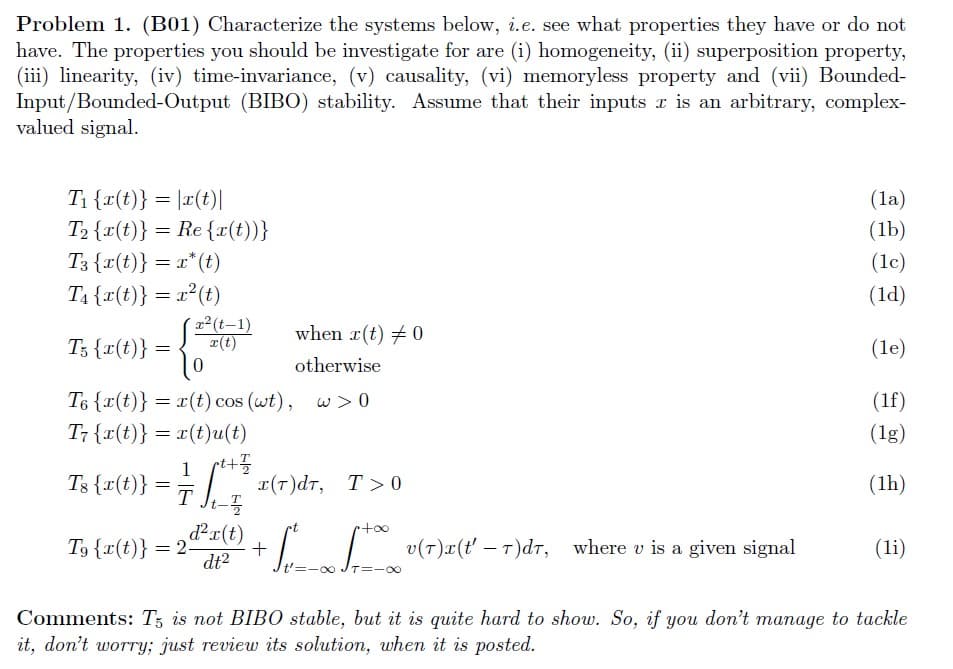Problem 1. (B01) Characterize the systems below, i.e. see what properties they have or do not have. The properties you should be investigate for are (i) homogeneity, (ii) superposition property, (iii) linearity, (iv) time-invariance, (v) causality, (vi) memoryless property and (vii) Bounded- Input/Bounded-Output (BIBO) stability. Assume that their inputs r is an arbitrary, complex- valued signal. T1 {r(t)} = |r(t)I (la)
Problem 1. (B01) Characterize the systems below, i.e. see what properties they have or do not have. The properties you should be investigate for are (i) homogeneity, (ii) superposition property, (iii) linearity, (iv) time-invariance, (v) causality, (vi) memoryless property and (vii) Bounded- Input/Bounded-Output (BIBO) stability. Assume that their inputs r is an arbitrary, complex- valued signal. T1 {r(t)} = |r(t)I (la)
Introductory Circuit Analysis (13th Edition)
13th Edition
ISBN:9780133923605
Author:Robert L. Boylestad
Publisher:Robert L. Boylestad
Chapter1: Introduction
Section: Chapter Questions
Problem 1P: Visit your local library (at school or home) and describe the extent to which it provides literature...
Related questions
Question
100%

Transcribed Image Text:Problem 1. (B01) Characterize the systems below, i.e. see what properties they have or do not
us-00 JT=-
have. The properties you should be investigate for are (i) homogeneity, (ii) superposition property,
(iii) linearity, (iv) time-invariance, (v) causality, (vi) memoryless property and (vii) Bounded-
Input/Bounded-Output (BIBO) stability. Assume that their inputs z is an arbitrary, complex-
valued signal.
T {x(t)} = |x(t)|
T2 {r(t)} = Re {x(t))}
(la)
(1b)
T3 {r(t)} = x*(t)
TA {r(t)} = x²(t)
x² (t-1)
(lc)
(ld)
when r(t) + 0
T3 {x(t)} =
r(t)
(le)
otherwise
T6 {r(t)} = x(t) cos (wt), w> 0
T7 {r(t)} = x(t)u(t)
(1f)
(1g)
1
Ts {r(t)} =
T
I(T)dr, T> 0
(1h)
dr(t)
T9 {r(t)} = 2.
dt2
t
rtoo
| v(T)x(t' –T)dr, where v is a given signal
(li)
Comments: T; is not BIBO stable, but it is quite hard to show. So, if you don't manage to tackle
it, don't worry; just review its solution, when it is posted.
Expert Solution
This question has been solved!
Explore an expertly crafted, step-by-step solution for a thorough understanding of key concepts.
This is a popular solution!
Trending now
This is a popular solution!
Step by step
Solved in 2 steps

Recommended textbooks for you

Introductory Circuit Analysis (13th Edition)
Electrical Engineering
ISBN:
9780133923605
Author:
Robert L. Boylestad
Publisher:
PEARSON

Delmar's Standard Textbook Of Electricity
Electrical Engineering
ISBN:
9781337900348
Author:
Stephen L. Herman
Publisher:
Cengage Learning

Programmable Logic Controllers
Electrical Engineering
ISBN:
9780073373843
Author:
Frank D. Petruzella
Publisher:
McGraw-Hill Education

Introductory Circuit Analysis (13th Edition)
Electrical Engineering
ISBN:
9780133923605
Author:
Robert L. Boylestad
Publisher:
PEARSON

Delmar's Standard Textbook Of Electricity
Electrical Engineering
ISBN:
9781337900348
Author:
Stephen L. Herman
Publisher:
Cengage Learning

Programmable Logic Controllers
Electrical Engineering
ISBN:
9780073373843
Author:
Frank D. Petruzella
Publisher:
McGraw-Hill Education

Fundamentals of Electric Circuits
Electrical Engineering
ISBN:
9780078028229
Author:
Charles K Alexander, Matthew Sadiku
Publisher:
McGraw-Hill Education

Electric Circuits. (11th Edition)
Electrical Engineering
ISBN:
9780134746968
Author:
James W. Nilsson, Susan Riedel
Publisher:
PEARSON

Engineering Electromagnetics
Electrical Engineering
ISBN:
9780078028151
Author:
Hayt, William H. (william Hart), Jr, BUCK, John A.
Publisher:
Mcgraw-hill Education,